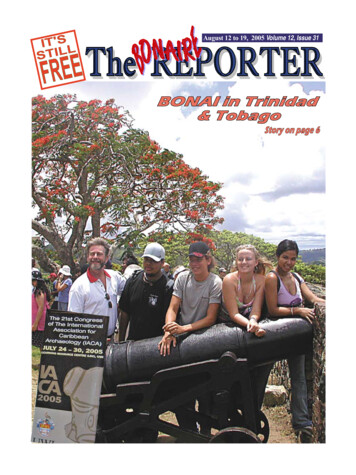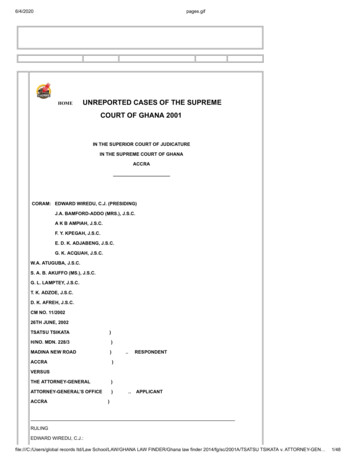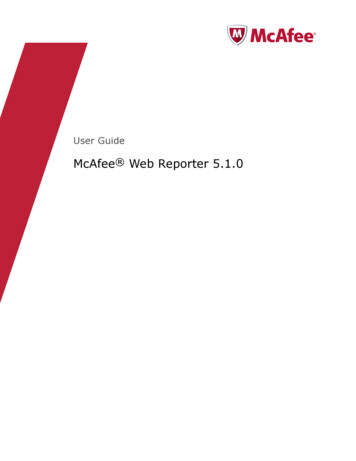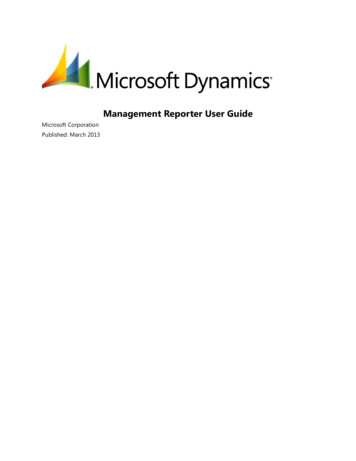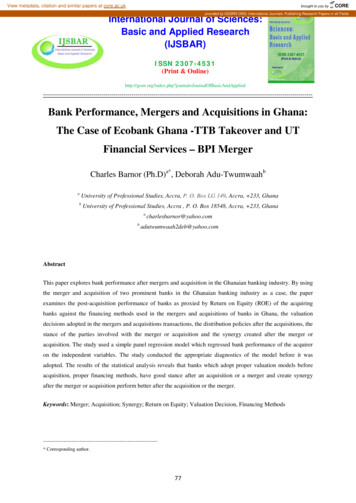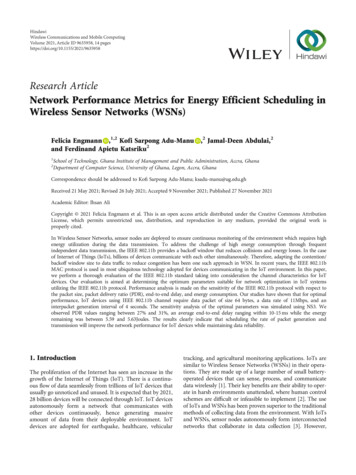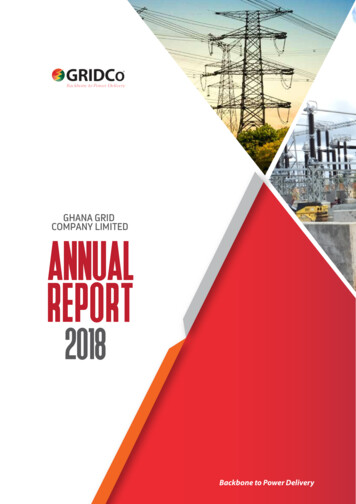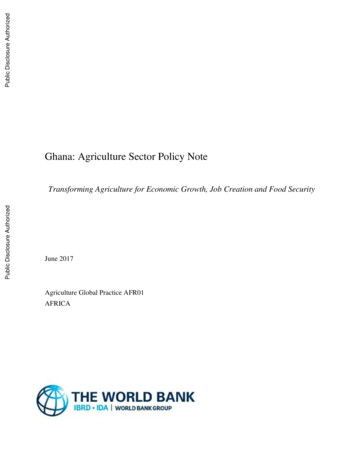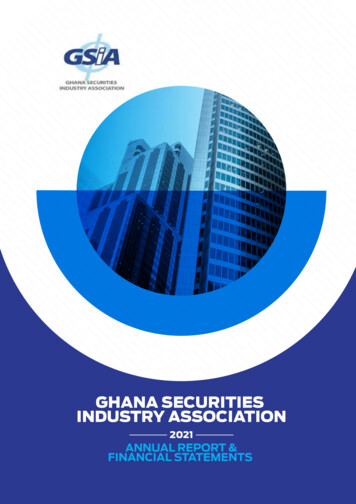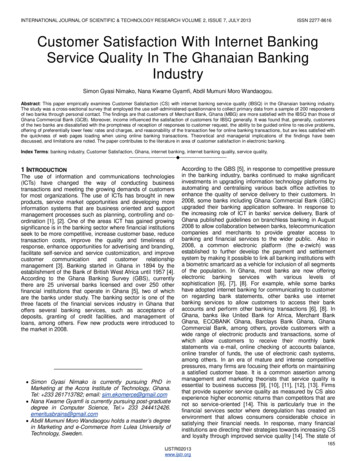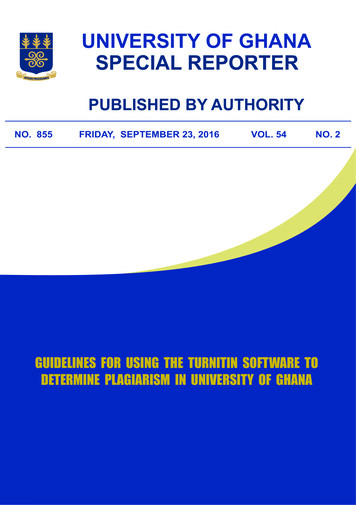
Transcription
UNIVERSITY OF GHANASPECIAL REPORTERPUBLISHED BY AUTHORITYNO. 855FRIDAY, SEPTEMBER 23, 2016VOL. 54NO. 2GUIDELINES FOR USING THE TURNITIN SOFTWARE TODETERMINE PLAGIARISM IN UNIVERSITY OF GHANA
Guidelines for using the Turnitin Software to Determine Plagiarism in University of Ghana1TABLE OF CONTENTS1.0 INTRODUCTION1.1Rationale for Use of Turnitin Software in University of Ghana221.2Overview of the Turnitin Software21.3Limitations of Turnitin32.0 GUIDELINES32.1Scope32.2Implementation Guidelines42.2.1 Use of the TURNITIN Originality Report32.2.2 Procedures for Submission of Work to the Sakai LMS/TURNITIN62.2.3 Investigating Plagiarism72.2.4 Departmental Level Processes73.0 SUMMARY4.0 REFERENCE DOCUMENTS910
2Guidelines for using the Turnitin Software to Determine Plagiarism in University of Ghana1.0INTRODUCTION1.1Rationale for Use of Turnitin Software in University of GhanaFollowing the approval of the UG Plagiarism policy, the TURNITINsoftware was introduced in University of Ghana (UG) to facilitate theimplementation of the policy. The introduction of the software at UG isone of the means to encourage faculty members, staff and students toabide by one of the core values of University of Ghana, which is Integrity.The use of the software is not intended to be punitive, but rather to providefaculty members, students and staff with the opportunity to identifyportions of their work that can be deemed as plagiarized so they can effectthe necessary corrections. It is intended to facilitate the process ofensuring academic integrity, which includes duly acknowledging the workor ideas of others. Its use will allow academic staff, students and othermembers of the University community to gain confidence that work whichthey submit as original meets the criterion of having a high level oforiginality.1.2Overview of the Turnitin SoftwareThe TURNITIN software is to be used primarily as an educational tool.The software compares the similarities of academic or any other writtenmaterial/work against a wide range of databases of published andunpublished materials of other writers that are available online, andprovides a report detailing the extent of text matching as represented by thecolour coded similarity index.As TURNITIN is essentially a text matching system, the report generatedidentifies those sections of the text that matches another text source in theTURNITIN repository. The overall total of text match will be expressed asa percentage (Similarity index) in each report. This percentage is forguidance only. TURNITIN does not indicate the acceptable level, andwould therefore not indicate that plagiarism has occurred. The judgment asto whether plagiarism has occurred is based on Institutional norms.The reported similarity index should therefore not be used as the only basisfor action. The decision to consider any work as plagiarized must be basedon an in-depth examination of the submitted material and the suspectedplagiarized material.
Guidelines for using the Turnitin Software to Determine Plagiarism in University of Ghana1.33Limitations of TURNITINa. TURNITIN does not offer a ready solution to plagiarism. Its use istherefore not a substitute for good academic writing practices, forexample, correct citation and referencing.b. There are significant gaps in its search base. For example, TURNITINmay not be able to accomplish the following:i.detect plagiarized work from books or sources which are 'old'and not available on the Internetii. detect work which is plagiarized by translating from onelanguage to another, for example, French text translated toEnglishiii. search all electronic journalsiv. detect images, graphs, mathematical equations that may havebeen plagiarized.2.0GUIDELINES2.1Scope1. The guidelines are limited to the use of the TURNITIN software tocheck plagiarism in student work at University of Ghana.2. The guidelines address the following common sources of plagiarism.a.Text matching (unacceptable percentage of text matching).b.Cut/ Copy and Paste material from the Web, textbooks orjournals (lifting phrases, sentences and paragraphs ofsomeone's work (published and unpublished) beyond anacceptable number of words)c.Quotation (Direct quotes not duly acknowledged). Forexample, using the APA format, present quotation in 'blockform' when the direct quote is more than 40 words.Conversely, use quotation marks for quotations of less than40 words and provide the source and page numberaccordingly. Also, quoting extensively from a single source(even if duly acknowledged) despite the availability of severalother sources.
4Guidelines for using the Turnitin Software to Determine Plagiarism in University of Ghanad.Paraphrasing (paraphrased views of others withoutacknowledgement)e.Copying the work of another studentf.Copying from course material, and lecture notesg.Copying laboratory data or other forms of data3. Reviewing the Originality reports of students' work e.g. graduatethesis/dissertation/long essay2.2Implementation GuidelinesThese guidelines are meant specifically for student work.2.2.1 Use of the TURNITIN Originality report1.Students must be required to submit all theses and longessays through the University Learning ManagementSystem(presently SAKAI), which will be set to generate aTURNITIN originality report with a similarity index.2.Instructors (Faculty) are encouraged to use the SAKAI LMSand to be familiar with the Assignment Tool in Sakai LMSsince it provides the easiest means for students to submit theirwork online3.Text matching (unacceptable percentage of text matchingusing TURNITIN colour coding). For University of Ghana,the following similarity indices are to be used. Thesesimilarity indices are not exclusive of each other though theycan be applied individually.i. Overall Similarity index: Should not exceed 20% (24%and below gives the colour code – Green, in TURNITIN,indicating that it within the acceptable range).ii. Single source similarity index: Should not exceed 2%iii. Acceptable number of words in an unbroken string(phrase or sentence): Should not exceed 10 words.4.Not with standing the above indices, the following should beapplied when deciding whether plagiarism has occurred ornot.
Guidelines for using the Turnitin Software to Determine Plagiarism in University of Ghana5i. Faculty should be mindful of the limitations ofTURNITIN (See section 1.3) and review theoriginality reports carefully;ii. Faculty should document in detail the processesleading to a student being charged with plagiarism andhence being sanctioned. Such documentation will beessential if there is an appeal.iii. The overall similarity index should not be used as theonly basis for determining that plagiarism hasoccurred. Each work should to be reviewedthoroughly through visual inspection of the matchedtext, irrespective of how high or low a similarity indexis. Similarly, the single source index and the number ofwords in a string that have been flagged should beexamined.iv. Where direct quotations have been properlyacknowledged they can be ignored.v. In the event where there is limited information in theresearch area, similarity index from a single sourceexceeding 2% should be further investigated beforetaking action.vi. Self-plagiarism. In the event where a portion of athesis has been published by the sameresearcher/author it can be overlooked after carefulvisual inspection has confirmed this.vii. Bibliography and extensive direct quotations, althoughduly cited, could present a high percentage match. TheTURNITIN software could be set to ignore suchmaterial.viii. Cover page and declaration information will be similarfor all students submitting their long essays/thesisand this can inflate the similarity index. This should beignored during the visual inspection.
6Guidelines for using the Turnitin Software to Determine Plagiarism in University of Ghana2.2.2Procedures For Submission of Work to the SakaiLMS/TURNITIN1. Instructors must let students know in advance if they areexpected to submit their assignments/lab reports/longessays/theses/dissertations through the SAKAI LMS2. Students can be allowed unlimited submissions of theirworks (draft) so as to enable them review the TURNITINreports that are generated before submitting their finalwork.3. The decision of how many submissions will be allowedshould be determined by the individual lecturer orsupervisor and communicated to the students.4. Students must be informed in advance how many timesthey will be allowed to resubmit an assignment or draftlong essays/dissertations/thesis through the Sakai LMS.5. There could be high similarity index for instances wherethe same work (draft) has been repetitively submitted toTURNITIN with the intention of editing out thematching portions. To avoid such reports attracting highsimilarity indices, draft work or any work in progressshould NOT be submitted to the standard repository ofTURNITIN until the final submission.6. Classwork, assignments and undergraduate projectreports/undergraduate long essays can be submitted tothe INSTITUTIONAL REPOSITORY to create adatabase against which works of other students who copyand submit the same work in future can be checkedthrough TURNITIN.7. It is advisable that any work, such as undergraduateassignments, which is meant for “internal purposes”,should not be submitted to the STANDARDREPOSITORY of TURNITIN.
Guidelines for using the Turnitin Software to Determine Plagiarism in University of Ghana2.2.37Investigating Plagiarism1. Investigative procedures as stated in the Plagiarism policywill apply where TURNITIN appears to indicate a breachof academic integrity.2. In the case of graduate thesis, the Graduate StudiesCommittee of the relevant department must be involvedin the investigation.3. The reported similarity index should not be used as theonly basis for action. Percentage levels above therecommended levels can be flagged for interpretation andinvestigated further. In such cases, the full report shouldbe examined to detect the magnitude of the matching text.4. An in-depth examination of the student's work and theplagiarized material is needed as part of the investigativeprocedure.5. CAVEAT: TURNITIN alone cannot prove that a studenthas plagiarized. Nonetheless, students cannot useTURNITIN to prove that they have not plagiarized. Suchjudgments should be the responsibility of the individualfaculty member/super visor/Graduate StudiesCommittee or any other appropriate authority.2.2.4 Departmental Level Processesa. Graduate Level1.During the graduate long essay/ dissertations /thesissupervision process, students must be allowed severalsubmissions in order to check and review the TURNITINreport, to reduce the similarity index as necessary. Students'work should NOT be submitted to either the TURNITINstandard repository or the institutional repository at thisstage.2.Supervisors should assist students to interpret theTURNITIN reports in order to help them review theirwritten material.
8Guidelines for using the Turnitin Software to Determine Plagiarism in University of Ghana3.All graduate students are required to print and attach a copyof the TURNITIN report to their thesis and submit to theDepartmental Graduate Studies Committee for approvalbefore submission to the Graduate School for grading.4.The Graduate Studies Committee must review the report andmake recommendations to the student for review of thethesis if the Committee deems the thesis to haveunacceptable levels of text matching.5.The Graduate Studies Committee should allow a student onechance to resubmit their work along with a new TURNITINreport if first submission is deemed to have had unacceptablelevels of text matching.6.All graduate theses/dissertations/long essays submitted tothe Graduate School for grading must be accompanied by aTURNITN report duly signed off by the Chair of theDepartmental Graduate Studies Committee. The Graduateschool does not have the responsibility of doing plagiarismchecks. This should be done at the Department/Institute inorder to avoid submission of thesis/dissertations to theGraduate School that may be deemed plagiarized.7.After grading and correction, the Hard-bound thesis must beaccompanied by a TURNITN Report signed by the Head ofDepartment.8.All final graduate theses/dissertations/long essays from UGshall be deposited in the INSTITUTIONALREPOSITORY within TURNITIN.9.The Final deposition of graduate theses/dissertations/longessays into the STANDARD TURNITIN Repository shallonly be done by the appropriate Balme Library staff at therequest of the Graduate School. This can be done only aftersubmission of the final hard bound copy along with theelectronic version.
Guidelines for using the Turnitin Software to Determine Plagiarism in University of Ghana910. Any work (submitted for grading or Hard Bound) that isdeemed to have been plagiarized should be subjected toinvestigative processes as per the UG Plagiarism policyb. Undergraduate Level1. To reduce the incidence of copying, undergraduate students mustalso be encouraged to submit their long essays/project reportsthrough the SAKAI LMS as part of the supervision process.Supervisors should assist their students to interpret theTURNITIN reports in order to help them rewrite the materialsreview their written material.2.Departments may decide on the exact modalities for reviewingTURNITIN reports of undergraduate work. These must becommunicated clearly to students.3.Any final submitted work that is deemed to have been plagiarizedshould be subjected to investigative processes as per the UGPlagiarism policy.3.0 SUMMARY1.Faculty and students should familiarize themselves with thecontents of theUniversity of Ghana Plagiarism Policy2.These guidelines should be used in conjunction with the Universityof Ghana Plagiarism Policy.3.The following similarity indices are recommended.i.Overall Similarity index should not exceed 20%ii. Single source similarity index should not exceed 2%iii. The acceptable number of words in an unbroken stringshould be a maximum of 10 words. Studentsubmissions must meet all three requirements to bedeemed acceptable.4.All graduate thesis/dissertation/long essays submitted to theGraduate school must have a TURNITIN report attached. TheGraduate School has the prerogative to recheck on TURNITIN
10Guidelines for using the Turnitin Software to Determine Plagiarism in University of Ghana(for verification purposes) any submitted work.5.Whenever appropriate, the academic work of students at all levelsshould be submitted to TURNITIN to alert students about theissue of plagiarism.6.Each department should ensure they have clear guidelines of whatis expected of students in terms of referencing of sourcematerials. This should begin from the undergraduate level (level100).7.Graduate Assistants/Teaching Assistants/National Servicepersons trained in the use of TURNITIN and how to do the visualinspection may be used by Faculty to help check the reportswhenever they cannot do so themselves.8.Faculty are encouraged to document challenges and successes intheir use of the TURNITIN software to check Plagiarism. Thiswill help evaluate the software continuously so it can be adapted tosuit the needs of UG better.9.SAKAI Team and Academic Quality Assurance Unit will facilitatec o n t i n u o u s Tr a i n i n g o n t h e u s e o f t h e S A K A ILMS/TURNITIN4.0REFERENCE DOCUMENTS1. UG Plagiarism Policy.2.TURNITN online Manual
2016, Public Affairs, University of Ghana
SPECIAL REPORTER UNIVERSITY OF GHANA PUBLISHED BY AUTHORITY NO. 855 FRIDAY, SEPTEMBER 23, 2016 VOL. 54 NO. 2 GUIDELINES FOR USING THE TURNITIN SOFTWARE TO DETERMINE PLAGIARISM IN UNIVERSITY OF GHANA. TABLE OF CONTENTS 1.0 INTRODUCTION 1.1 Rationale for Use of Turnitin Software in University of Ghana 1.2 Overview of the Turnitin Software 1.3 Limitations of Turnitin 2.0 GUIDELINES 2.1 Scope 2.2 .
